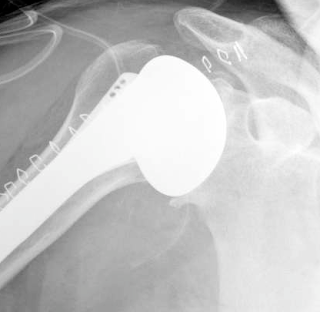Since one of the primary manifestations of shoulder arthritis is stiffness, our patients have taught us that gentle exercises, starting with gentle stretching, may be of help in improving comfort and function and delaying the progress of the arthritis. Patients have also shown us that exercises should not be continued if doing them worsens the symptoms in any way. Here are a few exercises that have been helpful to patients with shoulder arthritis. Each exercise is best done when the shoulder is relaxed. Ten to twenty repetitions are often effective, trying to get just a bit more motion with each one. Five gentle sessions a day will often keep the shoulder as loose as it can be. Here are some tips about the art of stretching.
We have also posted some videos of these exercises.
For stretching exercises, be sure to hold the stretch for a full two minutes.
I. The supine stretch in flexion. The shoulders are relaxed. The better arm is used to raise the stiffer arm up and toward a position parallel to the floor.
II. The forward lean. The shoulder is relaxed. The forearm is placed on a table while the person is seated. By leaning forward and sliding the seat back, the shoulder is gently stretched upward.
III. The pulley. With a pulley securely fixed above a seat, one arm pulls gently down, lifting the other arm up overhead.
IV. The gravity swing. With a light weight in the and and with the body bent over at a right angle, the arm is allowed to swing gently back and forth, side to side, and around in circles.
V. The lat pull. With minimal weight, the hands hold the bar allowing the weight to pull the arms up. The shoulders relax while the weight pulls them up.
The bar is brought down under the chin for a few seconds and then the shoulders are relaxed again as they are pulled up.
VI. The row (with all apologies to my patients who are real rowers). With the shoulders relaxed, the hands grasp the bar of the rowing machine.
Using the muscles of the legs and back, the bar is gently and slowly pulled backwards.
Using the muscles of the legs and back, the bar is gently and slowly pulled backwards.
Again, all exercises are started slowly and gently and progressed slowly. No exercise should be continued if it makes the symptoms worse.
Also thirty to sixty minutes of aerobic exercise a day (stair climber, treadmill, brisk walking, stationary bike, elliptical, water exercises) are most helpful in keeping the shoulder flexible.
To see some exercise videos click here.




























